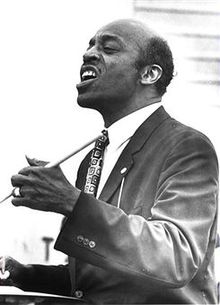Jo Jones
(Oct 7, 1911 – Sep 3, 1985)

Jonathan David Samuel Jones was born in Memphis, Tennessee, on October 7, 1911. He grew up in Alabama, and played trumpet, saxophone, piano, and vibes, also doing some singing and tap dancing in medicine shows, carnivals, and territory bands before switching to drums in the late 1920s. He worked with the band of trumpeter Lloyd Hunter for two years, starting in 1931, and then played piano and vibes with Tommy Douglas. That gig took him to Kansas City, where he began playing drums with Count Basie. He left Basie briefly to play with bassist Walter Page in the Jeter-Pillars Orchestra, but soon Jones and Page went back to the Basie band. When guitarist Freddie Green joined the band, Basie, Jones, Page, and Green became one of the most celebrated and influential rhythm sections of all time.
With the exception of a two-year period from 1944–46 when Jones served in the U.S. Army, he stayed with Basie until 1948. During those years, Jones also did some freelance work, including recordings with Billie Holliday and Teddy Wilson, and touring with Jazz at the Philharmonic, with whom he toured Europe several times.
After leaving Basie’s band, Jones led a trio and also worked with Illinois Jacquet’s band. During the 1950s he played with such artists as Lester Young, Ruby Braff, Joe Bushkin, Teddy Wilson, Ray Bryant, Art Tatum, and others. Jones also recorded with many prominent musicians during the 1950s, including Buck Clayton, Vic Dickenson, Roy Eldridge, Ben Webster, Zoot Simms, Bob Brookmeyer, Johnny Hodges, and others. Jones appeared at the 1957 Newport Jazz Festival with both Basie and the Coleman Hawkins-Roy Eldridge Sextet.
In the 1960s he worked with a quintet that included Eldridge, Coleman Hawkins, and Tommy Flanagan, and he continued recording with a variety of artists. He began working with organist Milt Buckner in 1966, and they performed and recorded together until 1974. He performed and recorded occasionally during the late 1970s and into the 1980s, with his last regular performances consisting of a once-a-week gig at the West End Café in New York. Jones died of pneumonia on September 3, 1985.
Jones is credited with transferring the basic pulse of jazz from the bass drum to the hi-hat cymbal. Jones would play on slightly open hi-hats, closing them on beats 2 and 4. This produced a more flowing sound than the more staccato approach of keeping the hi-hats closed, which was how the hi-hats were commonly played by his predecessors. Instead of pounding the bass drum on all four beats, he would play more softly, occasionally “dropping bombs” by accenting a bass drum note. Jones was also highly regarded for his brush playing.
In 1979, Jones was inducted into the Alabama Jazz Hall of Fame for his contributions to Alabama's musical heritage. In 1985 he was named a National Endowment for the Arts Jazz Master. Jones was elected to the PAS Hall of Fame in 1990.